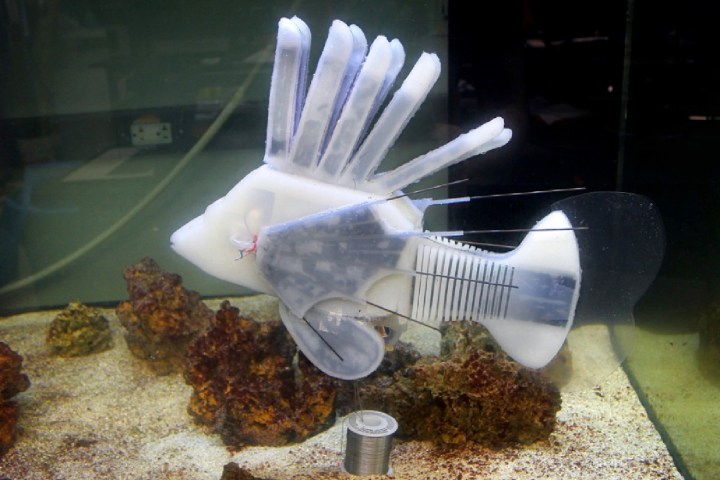
There are all sorts of impressive robots which exist in labs around the world. However, many of the most innovative ones have to be tethered to a power source in order to function — which greatly limits their functionality. Those which don’t have to be tethered must battle against the limitation of short battery life.
A new robot developed by researchers at Cornell University could solve these problems, however. They have built a swimming soft robot, modeled on the lionfish, which contains a pair of electrodes and a circulating liquid electrolyte likened by its creators to a kind of robot blood. This allows it to store up energy for use powering itself during long-duration tasks. The circulating liquid powers pumps in the robot fish’s tail, dorsal and pectoral fins.
“In nature we see how long organisms can operate while doing sophisticated tasks. Robots can’t perform similar feats for very long,” Rob Shepherd, associate professor of mechanical and aerospace engineering at Cornell, said in a statement. “Our bio-inspired approach can dramatically increase the system’s energy density while allowing soft robots to remain mobile for far longer.”
The results are an innovative robot that’s capable of swimming continuously for up to 36 hours. While that does mean that it would still need to recharge periodically, and couldn’t be left alone for long-term surveillance tasks or similar, it is far longer than most battery-powered robots are able to operate.
But there’s still room for improvement. Although undoubtedly impressive as a tech demo, Cornell’s lionfish-inspired robot can only swim at a speed of approximately 1.5 body lengths per minute. Translated to a more recognizable gauge of speed, that is around 0.01 kilometers per hour, which means that it’s not exactly the most fast-moving of robots. (It’s definitely a whole lot slower than a real lionfish, which are known for their fast-striking abilities.)
In other words, there is more work to do when it comes to optimizing this particular design. As the researchers note in the abstract of their research paper, though, “this use of electrochemical energy storage in hydraulic fluids could facilitate increased energy density, autonomy, efficiency and multifunctionality in future robot designs.”
Cornell’s lionfish robot project is detailed in a research paper, titled “Electrolytic vascular systems for energy-dense robots,” which was recently published in the journal Nature.
Editors' Recommendations
- Boston Dynamics uses ChatGPT to create a robot tour guide
- Robot pile-up causes grocery delivery chaos for online shoppers
- Omne Eternal safety-first cycling helmet uses the power of light to charge up
- This quirky humanoid robot can be teleoperated using a VR headset
- Future armies could use teams of drones and robots to storm buildings


